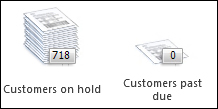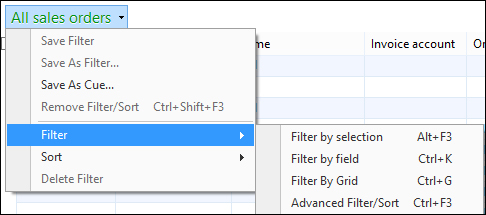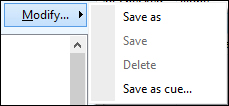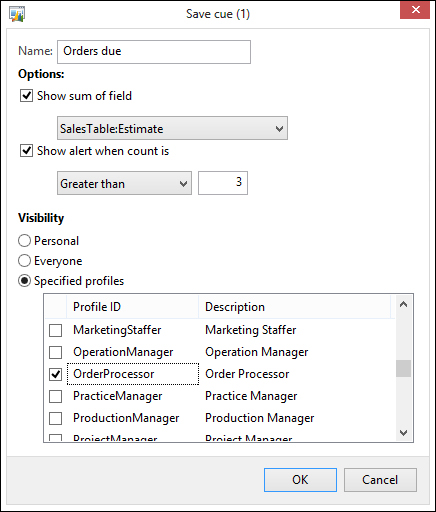Cues could be thought of as a Business Intelligence (BI) metric. They are entry points into AX that shows the user some information about the target (customer on hold, for instance). The following diagram depicts a Cue showing that there are 718 customers on hold, upon clicking this, the Customers list page will open filtered to the customers that are on hold.

These Cues are displayed in groups on the home page of the client or the enterprise portal. The home page is, in fact, the Role Center home page displayed in the client. The system has cognizance of this, and will open the list page in the correct client, showing a seamless integration between the two.
There are two methods to create a Cue. From the Application Object Tree (AOT) (as performed by a BI developer) or from the client itself. Most power users would be capable of creating a Cue for themselves, allowing these users to be able to help themselves with the information that is important to them.
The method described here is the method users will use to add Cues without requiring development skills.
For this task, you don't need to be a system administrator, but as we are going to create a Cue based on the sales order and customer information, you should have a role that lets you view this data.
In this example, we will create a Cue that shows the sales orders that are due within 2 days.
The following steps create a Cue from the sales order list page.
- Navigate to Accounts receivable | Common | Sales orders | All sales orders.
- Click on All sales orders | Filter | Advanced Filter/Sort (or press Control + F3).

- In the Inquiry – sales orders query edit form, click on Add within the Range tab.
- Leave Table and Derived table as Sales orders.
- Choose (or enter)
Ship datein the Field column (this is the confirmed shipping date of the order if entered, or the requested shipping date if blank). - To enter a relative date, use the
lessThanDatefunction. In the Criteria column enter(LessThanDate(2)), to filter orders with a confirmed shipping date of before today + 2.
- To view only open orders (orders with lines not yet delivered), add a second range for the Status field of the Sales order table, enter in the Criteria field
"Open order". - Check that we have the ranges set up, as per the following screenshot:

- On the top of the form, click on Modify... | Save as, as shown in the following screenshot:

- Enter the name
Orders dueand click on OK. - Click on OK on the Inquiry form.
- Click on All sales orders (Unsaved filter) and choose Save as Filter. Again, avoid the temptation to click on Save As Cue.... You may also notice the Delete Filter option is disabled, it doesn't think there is a saved filter.

- As before, name the filter
Orders dueand click on OK. - Since we already saved the query earlier, it will ask us if we wish to overwrite the query. Click on Yes.
- The filter text will change to All sales orders – Orders due, if you reopen the All sales orders list page, you will be able to reselect the query.
- Click on All sales orders – Orders Due and then click on Save as Cue. The following screenshot will appear:

- Enter a name in the Name field that users will select when adding this Cue (for example,
Orders due). - To view a sum within the Cue, check Show sum of field and select SalesTable:Estimate.
- To show an alert on the Cue based on record count, check Show alert when count is and choose an option such as Greater than, and enter the trigger amount in the adjacent field.
- Finally, choose the target audience; in this case we will want this available to the OrderProcessor role, but you can select multiple roles here.
- Then click on OK.
This method stores the Cue definition (and the query) in usage data, which can be lost if this is reset, refer to Chapter 3, Mode Management – Clearing Application User Caches and Usage Data. Cues that form organizational metrics should be written in the AOT by a developer.
The query tool used here is not new, and can be used throughout AX to filter data (even data in other related tables). Cues base their information on a saved query, presenting the result on the Cue.
The Cue is saved not only with a query definition, but also with the list page reference; clicking on the Cue will open the list page filtered to the saved query. This can be on the enterprise portal, or the AX client.
Along with the theme of saved queries, we can also create personal favorites. These favorites can be saved with the saved query.
If we right-click on All sales orders, we are offered the choice to Add to favorites..., as shown in the following screenshot:

We can then name the new favorite and select the Orders Due query, as shown in the following screenshot:

This favorite is now displayed in our favorites group, which can be very useful to users.
